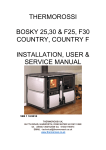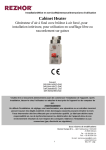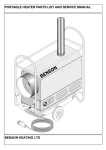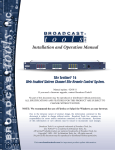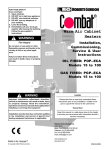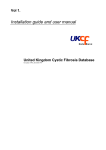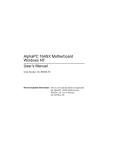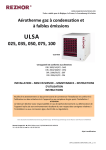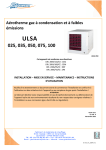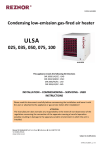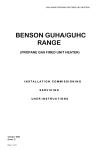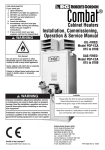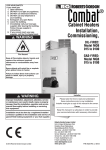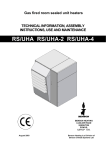Download BENSON HEATING LTD CVO 70 Technical data
Transcript
BENSON 2 VARIANTE RANGE NATURAL GAS (G20 I2H) PROPANE GAS (G31 I3P) TUBULAR HEATER INSTALLATION COMMISSI ONING SERVICING USER INSTRUCTIONS BENSON Issue 4 October 2007 33-64-695 THIS MANUAL SHOULD BE LEFT WITH THE END USER . TO ENSURE SERVICE AND MAINTENANCE INFORMATION IS AVAILABLE ON SITE 1 Section Contents Page No 1.0 Compliance Notices 4 1.1 Certificates of Conformity 5 1.2 General product Information 5 1.3 General Requirements 6 1.4 Delivery & Pre-installation Checks 6 1.5 Warranty 7 Special risk areas 7 2.0 Installation 8 2.1 Installation Clearances and Mounting Heights 8 2.2 Heater Mounting 9 2.3 Warm Air Circulation 10 2.4 Air Supply 10 2.5 Flue Installation 14 2.6 Electrical Installation 22 2.7 Gas Installation 23 3.0 Commissioning 24 3.1 Electrical Pre tests 24 3.2 Gas pre tests 24 3.3 Ignition Sequence 24 3.4 Hand Over 26 4.0 Servicing 26 4.1 Servicing Procedure 26 5.0 Fault Diagnosis 28 6.0 Wiring Diagrams 30 7.0 Technical Data 39 7.1 Technical Data Common Information 39 Pre Purge information 40 7.2 Technical Data Heater Specifications 42 8.0 Parts Listing 44 9.0 Dimensions 46 2 IMPORTANT NOTICE TO INSTALLERS Installers should satisfy themselves that the gas pipework installation is carried out in accordance with all current legislation, Codes of Practice and recommendations . Additionally it may be necessary to protect the gas valves which form part of the heater or burner assembly from potential pipe contamination particularly, but not exclusively , where copper gas pipework is used. In instances where copper pipework is to be used for all or part of a gas pipework installation, including short length final connections then we advise that installers consult with gas supplier or provider and satisfy themselves what additional precautions may be necessary Any reference made to Laws, Standards, Directives , Codes of Practice or other recommendations governing the application and installation of heating appliances and which may be referred to in Brochures, Specifications, Quotations, and Installation, Operation and Maintenance manuals is done so for information and guidance purposes only and should only be considered valid at the time of the publication. Benson Heating cannot be held responsible from any matters arising from the revision to or introduction of new Laws, Standards, Directives, Codes of Practice or other recommendations. 3 1.0 Compliance notices The Benson Variante range of warm air heaters detailed herewith are manufactured by Benson Heating within a strictly controlled environment within the parameters of ISO9001: 2000 These instructions are only valid if the following country code is on the appliance GB. IE. If this code is not present on the appliance, it is necessary to refer to the technical instructions which will provide the necessary information concerning the modification of then appliance to the conditions of use for the country. The Benson Variante Range has been independently tested and assessed, and has been found to meet the Essential Requirements of the following European Directives. Gas Appliance Directive (90 / 396 / EEC) Machinery Directive (89 / 392 EEC) Low Voltage Directive (73 / 23 / EEC & 93 / 68 / EEC) Electromagnetic Compatibility Directive (98 / 336 / EEC & 91 / 31 / EEC) Product Liability Directive 65 / 374 / EEC) Where proprietary items are incorporated into Benson Heating products, detailed information and instructions are also provided as part of the information pack. It is the responsibility of the installer, owner, user, or hirer, of such products supplied by Benson Heating, to ensure that they are familiar with the appropriate information manuals, supplied by the manufacturer, and that they are suitably aware of the purpose of the manuals and the safety instructions. In addition, operators must be suitably trained in the use of the appliance so as to ensure its continued safe and efficient use. Benson Heating has a commitment to continuous improvement, and therefore reserves the right to amend or change the specification of the Variante Heater range subject to agreement from The Notified Body. Contained within the text of the manual, the words 'Caution' and 'Warning' are used to highlight certain points. Caution is used when failure to follow or implement the instruction (s) can lead to The manufacturer has taken reasonable and premature failure or damage to the heater or its component parts. practical steps to ensure that Benson Variante Range of Heaters are safe and Warning is used when failure to heed or without risk when properly used. These heaters should therefore only be used in the implement the instruction (s) can lead to not only component damage, but also to a manner and purpose for which they were hazardous situation being created where intended, and in accordance with the there is a risk of personal injury. recommendations detailed herewith. The heaters have been designed, manufactured, assembled, inspected, and tested, with safety and quality in mind, there are certain basic precautions which the installer and user should be aware of, and they are strongly advised to read the appropriate sections of the information pack accompanying the heater, prior to installation or use. The Benson Variante range of heaters conform to the following European Harmonised Standards. Benson Heating supports all new products being supplied to their customers with a comprehensive information pack; this clearly defines mandatory instructions for the safe installation, use, and maintenance, of the Appliance (s). BS EN - ISO 12100-1:2003 & BS EN - ISO 12100-2:2003 Safety of Machinery - Basic Concepts, General Principles for Design Part 1 & Part 2 4 BS EN 1020 Requirements for non domestic gas fired forced convection air heaters for space heating incorporating a fan to assist transportation of combustion air and/ or combustion products. BS EN 60204 - Part 1 : 1993 Safety of Machinery - Electrical Equipment for Machines Specification for General Requirements BS EN 60335 - Part 1 : 1988 Safety of Household and Similar Electrical Appliances General Requirements BS EN 55014 - 1993 Limits and methods of measurement of radio disturbance characteristics of electrical motor-operated and thermal appliances for household and similar purposes, electrical tools and similar electric apparatus BS EN 50165 - 1997 Electrical Equipment of non-electric heating appliances for household and similar purposes, safety requirements Variante heaters have been approved for alternative flue discharge arrangements These are detailed in following page’s Cabinet Manufactured from electro-zinc coated steel, finished in a durable stove enamelled polyester powder paint. Heat Exchanger Manufactured from aluminised dimpled steel tube formed into a W shape to give enhanced efficiency . Flue / Combustion Air Spigot Each heater is fitted with two spigots both of which are located to the rear of the appliance One of the pair is for connection for the flue whilst the other is a screened combustion air intake WARNING (SEE FLUE INSTALLATION 2.5 PAGE 14) The Benson Variante range of gas unit heaters meet with the governments criteria in Burner respect of the Enhanced Capital Allowance The induced draught multi in-shot burner Scheme assembly is manufactured from aluzinc coated steel and mounted to a common steel 1.1 Certificates of conformity manifold which can be easily withdrawn through the burner access compartment. Declarations and Certificates are available upon request from the Quality Control Burner Control Department at Benson Heating . Notified Body PIN Reference is The heaters are fitted with automatic ignition 063BQ5461 for all models within the range. 1.2 General product information Exhaust Fan The Benson Variante range includes for 10 model sizes with outputs from 12.0 kW to 144.0 kW, Each model can be configured for use as axial fan crossflow (VRA) centrifugal fan (VRC) and axial fan downflow (VRE) Combustion gases are evacuated to atmosphere via an in built power flue venter fan which is safety interlocked to the gas valve via an air pressure proving device Air Movement Fan VRA / E) are supplied with an Axial fan for Variante heaters are suitable for operation on free blowing applications . natural gas (G20) or LPG (Propane (G31) Variante (C) are supplied with Centrifugal fans suitable for ducted applications Note The Model Range is made up as follows Neither asbestos nor soft soldered joints are used in the construction or manufacture of Model No 40 70 100 135 170 the Benson VRA/C/E range of Heaters. The materials selected for use can 12 19.6 29.4 39.2 49.0 withstand the mechanical, chemical, and Output kW thermal stresses which they will be subject to Model No 200 250 330 410 490 during foreseen normal use when installed in accordance with the manufacturers 58.8 72.0 96.0 120.0 144.0 Output kW recommendations. 5 e) The position of the heater relative to the supply of fresh air 1.3 General Requirements Caution Before installation, check that the local distribution conditions, nature of gas and pressure, and the current state adjustment of the appliance are compatible. Warning Unauthorised modifications to the appliance, or departure from the manufacturers guidance on intended use, or, installation contrary to the manufacturers recommendations may constitute a hazard. f) The position of the heater relative to potential stratification / circulation problems, which generally occur at higher levels and which may be overcome through the provision of a suitable de-stratification unit. g) The position of the heater relative to service and maintenance requirements Caution The heater must not be installed within an area where the conditions are unsuitable, e.g. where the atmosphere is highly Note To ignore the warning and caution notices, corrosive, has a high degree of salinity, or where high wind velocities may affect burner and to ignore the advice from the manufacturer on installation, commissioning, operation. Suitable protection should be provided for the appliance when it is located servicing, or use, will jeopardise any in a position where it may be susceptible to applicable warranty, moreover, such a situation could also compromise the safe and external mechanical damage from; for example, fork lift trucks, overhead cranes efficient running of the appliance itself, and etc. thereby constitute a hazard. This appliance must be installed by a competent person and in accordance with European, National, and Local criteria, including any relevant standards, codes of practice the requirements of the current building Regulations (and in particular parts J & L), Health and safety regulations IEE regulations and any requirements of the local Authority, Fire Officer or insurers Relevant standards may include BS6230, BS6891 and BS5588 parts 2 and 3 1.4 Delivery and pre-installation checks The heater is supplied wrapped in heavy duty protective polythene, mounted on a pallet. On receipt of the heater, the following checks should be carried out; a) The model is as per order b) That it is undamaged Prior to installation the following points should be considered; c) That it is suitable for the gas supply and pressure a) The position of the heater for the optimum efficient distribution and circulation of warm d) That it is suitable for the electrical supply air If any of these points are not satisfied then b) The position of the heater relative to the contact should be made with the Sales Office route of the flue at Benson Heating as soon as possible by telephoning 01547-528534. In the case of c) The position of the heater relative to the claims for damage, this must be reported in supply of gas writing within 24 hours of delivery, in order to comply with insurance criteria d) The position of the heater relative to the electrical services, wiring routes, and if appropriate, any additional controls. 6 1.5 Warranty The heater is supplied with a 1 year parts and labour warranty and a further year on all parts excluding consumable’ s. In addition to this there is also a 10 year time related warranty on the combustion chamber. The warranty commences from the date of dispatch from the manufacturer, and is subject to the terms detailed within the Benson Heating 'conditions of business'. following information to enable processing to take place; (1) Heater model (2) Heater serial number (3) Order reference/date of order, together with full installation details (name and address) (4) Details or symptoms of fault (5) Installers name and address. Faulty parts must be returned to the Benson Heating Spares Department, the address of which is provided on the cover of this Note (i) manual. Any such parts will undergo The warranty may be invalidated if a) The warranty registration/commissioning inspection to verify the claim. Replacement card has not been completed and returned to parts supplied prior to this may be charged, and a credit supplied upon subsequent Benson Heating validation of the warranty claim. b) The installation is not in accordance with Consumable items are specifically not included within the scope of the warranty. the general requirements of this manual c) The flue arrangement and air supply for the heater are not in accordance with the manufacturers recommendations, codes of practice, or similar standards Note (iii) Notification is required immediately a fault is suspected. The manufacturer will not accept responsibility for any additional damage that has been caused, expense incurred, or d) Air flow through the heater is not in accordance with the manufacturers technical consequential loss resulting from any failure of the heater(s). specifications SPECIAL RISK AREAS Where it is proposed to install a heater within a special risk area (e.g. an area containing flammable vapours where petrol engined vehicles are stored parked or f) The main electrical supply input to the serviced where paint spraying occurs, or heater has been interrupted during the where woodworking machinery or other heating mode flammable dust creating process’s are employed then restrictions, additional g) The heater has been subject to and affected by the ingress of water in any form regulations concerning the heater flue wiring or controls may apply. h) The heater is not operated at the rating(s) It is strongly recommended that you contact Benson Technical before installation laid down in the manufacturers technical Caution specifications When used in room sealed mode it may be i) The heater has not been operated or used possible to install Variante heaters in areas containing flammable vapours, high levels of within the normal scope of its intended airborne dust combustible dust chlorinated or application halogenated hydrocarbons degreasing solvents styrenes other laminating materials j) The manufacturer's recommended or airborne silicones. Benson Technical minimum service requirements have not should be contacted before installation . been complied with Failure to do so may invalidate or reduce Note (ii) guarantee cover. All warranty claims must contain the e) Internal wiring on the heater has been tampered with or unauthorised service repairs undertaken 7 Plant Room Siting Provided certain criteria are met it is possible to install VRC (centrifugal fans) within a plant room heaters installed in plant rooms should only be configured for use in room sealed mode and provision should be made for the positive connection of flues , combustion air pipes, warm air discharge and return ductwork where such a siting is a requirement it is recommended that you consult Benson Technical prior to installation Additionally the maximum temperature within the plant room should not exceed 320C 2.0 Installation The location chosen for the heater must allow for the fitting of an effective flue system. The location must also allow for adequate clearance for the air supply, return air circulation, gas supply, electrical supply, whilst also providing good and safe working access. The heater must be installed so that it is level, supports for the heater must be sufficiently robust to withstand the weight of the heater and any ancillary equipment Any combustible material adjacent to the heater or flue system must be so placed or shielded so that its surface temperature does not exceed 650C. Generally a free blowing heater should be located at a height (measured from floor level to the base of unit) as detailed within section 2.1 VRA free blowing heaters are at their most effective when located as close to the working area as possible. However care should be exercised to avoid directing the discharged air directly onto the occupants of the area to be heated. Where the passage of cold air causes problems (e.g. by entrances, loading bays etc) it is considered favourable if the heater is positioned so as the discharge towards or across the cold air source from a distance from 1.5m - 6m dependent upon the size of the entrance and the air throw characteristics of the heater. On exposed walls heaters should be positioned so as to discharge towards, or along the length of the exposed wall. 8 In areas where it is proposed that more than one heater is to be installed, a general scheme of circulation should be drawn up and maintained, thereby offering the best heat distribution. Air pressure within the area heated and the outside air pressure must remain the same, factors influencing this would be the presence of extraction systems, ventilation systems, and various types of process plant. VRA heaters are only suitable for free blowing applications or where the duct length does not exceed 2 metres. In which case the cross- section of the duct must be at least the same as that of the heater discharge grille VRE heaters configured for down flow applications should be suspended centrally over the area into which the warm air is to be discharged . 2.1 Installation Mounting Heights and Clearances The Heater must be installed within the mounting heights indicated below The following heights in metres Model VRA/C 40 70 100 135 170 Min 1.8 1.8 2.0 2.0 2.4 Max 2.3 2.3 2.5 2.5 3.0 Model VRA/C 200 250 330 410 490 Min 2.4 2.4 2.4 2.4 2.4 Max 3.0 3.5 3.5 3.5 3.5 Model VRE 40 70 100 135 170 Min 3.5 4.0 4.0 4.0 5.0 Max 4.5 5.5 6.0 7.0 8.0 Model VRE 200 250 330 410 490 Min 5.0 5.0 6.0 6.0 6.0 Max 12.0 8.0 10.0 12.0 12.0 Clearances VRA in mm Model 40 70 100 135 170 200 250 330 410 490 Above 300 300 300 300 300 300 300 300 300 300 Below 300 300 300 300 300 300 300 300 300 300 Right side 250 250 250 250 250 250 250 250 250 250 Left side 800 800 800 800 800 800 950 950 950 950 Rear 300 350 400 500 500 560 560 560 560 630 Clearances VRC in mm Model 40 70 100 135 170 200 250 330 410 490 Above 300 300 300 300 300 300 300 300 300 300 Below 300 300 300 300 300 300 300 300 300 300 Right side 250 250 250 250 250 250 250 250 250 250 Left side 800 800 800 800 800 800 950 950 950 950 Rear 200 200 200 200 200 200 200 200 200 200 Clearances VRE in mm Model 40 70 100 135 170 200 250 330 410 490 Above 1500 1500 1500 1500 1500 1500 1500 1500 1500 1500 Below 4000 4000 4000 4000 5000 5000 6000 6000 6000 6000 Right side 250 250 250 250 250 250 250 250 250 250 Left side 800 800 800 800 800 800 950 950 950 950 Rear 250 250 250 250 250 250 250 250 250 250 Left hand side = burner compartment side b) VRA heaters can be mounted on specifically designed cantilever wall or vertical stanchion brackets which locate The heater and flue must be adequately supported by one of the following methods ; directly to the four M10 fixings on the heater casing. Alternatively VRA or VRC units can be a) Suspension by steel drop rods or straps from the M10 fixing points located on top of mounted on cantilever type wall brackets however consideration must be given to the heater These must be of sufficient strength to safely ensure that the bracket is large enough to support the heater whilst providing the carry the weight of the unit and ancillary necessary clearances equipment. The straps may only drop vertically to eyebolts, if used; I.E. They must In either case the installer should ensure that not be joined to the eyebolt at an angle to the the wall wall fixings or other support medium vertical, and eyebolts if used should be of an is capable of supporting the weight approved type. 2.2 Heater Mounting 9 c) On a level non-combustible surface capable of adequately supporting the weight of the unit and ancillary equipment . OR • If the design air change rate of the heated space is 0.5 air changes per hour or greater The design air change rate may be satisfied 2.3 Warm Air Circulation by natural infiltration or by mechanical The air heater should be positioned to enable ventilation. maximum circulation of discharged warm air Combustion air ventilation within the area to be heated, whilst taking will be required if account of personnel within the area, sources of cold air ingress , and obstructions. • The heater(s) are installed with flue only (ie without the positive connection Ensure louvres are adjusted outwards to atmosphere of a combustion airduct) and ensure blades are not resonating And The design air change rate of the The air temperature rise on passing the heat • heated space is less than 0.5 air exchanger is typically around 340 C changes per hour A full and unobstructed return air path to the air heater must be provided Where heater(s) are installed without the (see 2.4 Air Supply). positive connection of combustion ductwork within a heated space where air change rate Where the heater is positioned to deliver blown air through an opening in a wall, return of that heated space is less than 0.5 air changes per hour then it will be necessary to air intakes should be located so that they provide either natural ventilation openings to cannot become blocked. Similarly these intakes must be positioned so as not to draw the heated space (Section 2.4.1.1 refers) or the mechanical ventilation of the heated in odours, fumes, hazardous vapours or space (Section 2.4.1.2 refers) particles. 2.4 Air Supply for Combustion and Ventilation 2.4.1.1 Natural Ventilation Openings to the Heated Space Consideration must be given to the provision of air for the purposes of combustion and ventilation of the heated space, plant room or enclosure where the heaters are to be installed . It is strongly recommended that BS 6230 : 2005 is referred to for further information concerning ventilation requirements If the heater(s) are to be installed without the positive connection of combustion air ductwork within a heated space, and where the design air change rate of that heated space is less than 0.5 air changes per hour, then provision for low level natural ventilation openings only will be necessary. The minimum free area of the low level natural ventilation opening shall be 2.4.1 Heaters installed within the heated space • 2 cm2 for each kW of rated heat input Where heaters are installed within the heated space (i.e. not a plant room , or enclosure ) The low level natural ventilation opening should be situated on an external wall and be then within 1000 mm of floor level for natural gas Combustion air or heater related ventilation and ideally at floor level for lpg gas installations but in any event no higher than air will not be required if 250 mm. • The heaters are installed in room sealed mode (ie with a positive connection to atmosphere of both flue and combustion air) 10 The table below provides specific data for each heater model as Minimum Free Area Of Ventilation Opening MODEL High Level Low Level cm2 cm2 40 None 26 70 None 43 100 None 64 135 None 86 170 None 107 200 None 128 250 None 158 330 None 211 410 None 263 490 None 315 2.4.2 Heaters Installed within a Plant Room or Enclosure A plant room means a room housing the heater plant and probably other items of building service plant and would generally have generous space for maintenance An enclosure is where the heater is installed within a compartment or confined area where space is limited Where heaters are installed within a plant room or enclosure then provision for both combustion air and / or air for general ventilation will be required by means of high and low level ventilation openings (sections 2.4.2.1 and 2.4.2.2 refer to plant room applications and sections 2.4.2.3 and 2.4.2.4 refer to enclosure applications). Alternatively the plant room or enclosure may be mechanically ventilated (section 2.4.2.5 refers) 2.4.1.2 Mechanical Ventilation to the Heated Space In the event that the heater(s) are to be installed without the positive connection of combustion ductwork within a heated space and where that heated space has a design air change of less than 0.5 air changes per hour and that the installer prefers to mechanically ventilate the heated space rather than provide ventilation openings then - 2.4.2.1 Natural Ventilation Openings to Plant Rooms for Room Sealed Heaters For plant room applications the minimum free area of ventilation opening will depend upon whether the heater(s) is installed in room sealed mode (ie with a positive connection to atmosphere of both flue and combustion air) Or with flue only (ie without the positive connection to atmosphere of a combustion air duct) Where the heater(s) is installed in a plant room and in room sealed mode (ie with a positive connection to atmosphere of both flue and combustion air ) the minimum free area of ventilation opening needs to be • The heated space needs to be mechanically ventilated so that the design air change is 0.5 air changes per hour or greater. • It is a requirement that the mechanical • ventilation shall be of the ! Input ! Type with either natural or mechanical extraction • • • Systems of mechanical extraction with a natural inlet shall not be used At high level 5 cm2 for each kW of rated heat input At low level 5 cm2 for each kW of rated heat input The high level ventilation opening should be sited on an external wall and positioned as It is necessary to provide an automatic high as is practical and always within the top means to safely inhibit heater(s) 15% of the wall height operation should mechanical air supply fail for any reason 11 The low level natural ventilation opening should be situated on an external wall and be within 1000 mm of floor level for natural gas and ideally at floor level for l.p.g gas installations but in any event no higher than 250 mm. should be situated on an external wall and be within 1000 mm of floor level for natural gas and ideally at floor level for l.p.g gas installations but in any event no higher than 250 mm. 2.4.2.3 Natural Ventilation Openings to 2.4.2.2 Natural Ventilation Openings to Enclosures for Room Sealed Heaters Plant Rooms for Flued Heaters The table below provides specific data for each heater model as The table below provides specific data for each heater model as - Minimum Free Area Of Ventilation Opening Minimum Free Area Of Ventilation Opening MODEL High Level cm 2 Low Level cm2 High Level Low Level cm2 cm2 40 26 52 40 65 65 70 43 85 70 106 106 100 64 128 100 160 160 135 86 171 135 213 213 170 107 214 170 267 267 200 128 256 200 320 320 250 158 316 250 394 394 330 211 422 330 527 527 410 263 525 410 656 656 490 315 630 490 787 787 Where the heater(s) is installed in a plant room and in flue mode (ie without a positive connection to atmosphere of combustion air ductwork ) the minimum free area of ventilation opening needs to be • MODEL At high level 2 cm2 for each kW of rated heat input For enclosure applications the minimum free area of ventilation opening will also depend upon whether the heater(s) is installed in room sealed mode (ie with a positive connection to atmosphere of both flue and combustion air) Or with flue only (ie without the positive connection to atmosphere of a combustion air duct) Where the heater(s) is installed in a plant At low level 4 cm2 for each kW of rated room and in room sealed mode (ie with a heat input positive connection to atmosphere of both flue and combustion air ) the minimum free The high level ventilation opening should be area of ventilation opening needs to be sited on an external wall and positioned as high as is practical and always within the top • At high level 5 cm2 for each kW of 15% of the wall height rated heat input • • The low level natural ventilation opening 12 At low level 5 cm2 for each kW of rated heat input The high level ventilation opening should be sited on an external wall and positioned as high as is practical and always within the top 15% of the wall height The low level natural ventilation opening should be situated on an external wall and be within 1000 mm of floor level for natural gas and ideally at floor level for l.p.g gas installations but in any event no higher than 250 mm. sited on an external wall and positioned as high as is practical and always within the top 15% of the wall height The low level natural ventilation opening should be situated on an external wall and be within 1000 mm of floor level for natural gas and ideally at floor level for l.p.g gas installations but in any event no higher than 250 mm. 2.4.2.5 Mechanical Ventilation to a Plant Room or Enclosure 2.4.2.4 Natural Ventilation Openings to The table below provides specific data for Enclosures for Flued Heaters each heater model as The table below provides specific data for each heater model as - Minimum Free Area Of Ventilation Opening MODEL Minimum Free Area Of Ventilation Opening MODEL High Level cm 2 Low Level cm2 High Level Low Level 40 65 130 cm2 cm2 70 106 212 40 65 65 100 160 320 70 106 106 135 213 426 100 160 160 170 267 533 135 213 213 200 320 640 170 267 267 250 394 788 200 320 320 330 527 1053 250 394 394 410 656 1312 330 527 527 490 787 1574 410 656 656 490 787 787 In the event that the installer prefers to mechanically ventilate the plant room or enclosure rather than provide ventilation openings then - Where the heater(s) is in an enclosure and in flue only mode (ie without a positive • connection to atmosphere of combustion air ductwork ) the minimum free area of ventilation opening needs to be • At high level 5 cm2 for each kW of rated heat input • At low level 10 cm2 for each kW of rated heat input • The high level ventilation opening should be 13 The plant room or enclosure needs to be mechanically ventilated at the rate of 4.14 m3/h of fresh air per kW or rated heat input. It is a requirement that the mechanical ventilation shall be of the ’input’ type with either natural or mechanical extraction. Where mechanical extraction is selected then the extraction rate should be 5%-10% less than the input rate. • Systems of mechanical extraction with a natural inlet shall not be used WARNING On VRA/C 200 to 490 a Combustion Air Plate is supplied as standard this MUST • It is necessary to provide an automatic be fitted in place of the combustion air means to safely inhibit heater(s) spigot if the heater is to be installed in the operation should mechanical air supply flue only option fail for any reason The flue assembly must comply with all the The table below provides specific data for relevant regulations regarding height and each heater model as materials, and must terminate with an approved flue terminal. Care should be taken to ensure that the flue Mechanical Ventilation terminal is not situated in a high pressure MODEL Rate for Plant Room or area, the proximity of buildings and other obstacles which will influence this must be Enclosure taken into account, preferably at the design M3/h stage. 54 40 All Variante Heaters are equipped with a built in flue venter fan which prevents the 88 70 re circulation of combustion products, 133 consequently an external draught diverter, 100 barometric damper, or anti spillage system 177 135 must not be installed. Such devices are unnecessary on the BVA/C range of heaters. 221 170 200 265 250 327 330 436 410 543 490 652 Horizontal flue installations must not exceed the following VRA/C 040 3 Metres overall length. VRA/C 070/200 6 Metres overall length. VRA/C 250/490 8 Metres in overall length. 2.5 Flue Installation. An integral flue spigot is fitted to all Variante Air Heaters thereby allowing the flue to connect directly to the heater. The design of the flue must ensure that it can be disconnected to allow for cleaning and servicing. All joints should be sealed between the sections. Warning It is essential that the products of combustion are flued to the outside of the building. Each heater must have its own separate flue, with a flue diameter of not less than is detailed in section 7.2 within this manual. 14 Each 900 bend corresponds to 1Mtr of flue length Each 450 bend corresponds to 0.8 Mtr of flue length Flue pipe should be supported at intervals not exceeding 1.8 mtrs In order to provide adequate natural draught, the minimum length of horizontal flue must not be less than 1Mtr. For vertical flue installations the flue should rise vertically where possible bends should not exceed 450 and the number of bends should be kept to a minimum. Maximum vertical flue length must not exceed 10 Metres The temperature of the combustion products can be as high as 1700 C and therefore tend to rise naturally within the flue. Unnecessary bends and restrictions should therefore be avoided. Provision for the disconnection of the flue for servicing and inspection purposes must also be made. The position of the flue and its terminal should be such that it does not impair the combustion process. It should terminate in an exposed position so as to allow the free escape of flue gases without risk of their reentering the building through windows, ventilation ports etc. The following distances in mm’s should be observed 200 below guttering or eaves 300 from corners or openings (windows doors etc) and from other horizontal terminals on same wall 1200 from a facing surface 1500 from another terminal vertically on the same wall 2000 from ground level The heaters must be connected to the flue system supplied by Benson Heating and be capable of withstanding the stresses and loadings associated with normal use. When designing the flue system the prevention of the formation and entrapment of condensation must be a key consideration. Horizontal flue should be fitted ensuring a slight gradient approx 20 towards the terminal Where condensation is unavoidable traps should be included to encourage the condensates to flow freely to a point from which they may be released, preferably into a gully. The condensate pipe from the flue to the disposal point must be made from corrosion resistant pipe of not less than 25mm internal diameter. If the flue passes through a wall, ceiling, or roof made from combustible material then it has to be sleeved so as to provide a minimum of a 25mm void between the exterior of the flue and the internal wall of the sleeve. 15 C32 Vertical Co axial flue Kit options L1 maximum flue length 10 metres Kit comprises Item (1) Co-axial flue terminal Ø 80 x Ø 80 Item (3) 900 by Ø 80 bend x 2 Part No 33-55-010 33-54-005 Extra pipes to extend the flue are available as an option Pipe Pipe Pipe Bend Ø Ø Ø Ø 80 x 1000 mm 80 x 250 mm 80 x 500 mm 80 x 450 16 33-54-001 33-54-002 33-54-003 33-54-004 C32 Vertical Co axial flue Kit options L1 maximum flue length 10 metres Part No Kit comprises Item (1) Co-axial flue terminal Item (2) Ø100 x 250 mm pipe Item (3) 900 by Ø100 bend x 1 Item (4) 450 by Ø100 bend x 2 33-55-107 33-54-103 33-54-105 33-54-104 Extra pipes to extend the flue are available as an option Pipe Ø 100 x 1000 mm Pipe Ø 100 x 500 mm Pipe Ø 100 x 250 mm 17 33-54-101 33-54-102 33-54-103 C32 Vertical Co axial flue Kit options L1 maximum flue length 10 metres Part No Kit comprises Item (1) Co-axial flue terminal Item (2) Ø130 x 250 mm pipe x 2 Item (3) 900 by Ø130 bend x 2 33-55-207 33-54-203 33-54-205 Extra pipes to extend the flue are available as an option Pipe Ø 130 x 1000 mm Pipe Ø 130 x 500 mm Pipe Ø 130 x 250 mm Bend Ø 130 x 450 18 33-54-201 33-54-202 33-54-203 33-54-204 Option B22 In this configuration the heater is connected to a single flue pipe to discharge the products of combustion outside the building either through the roof or through a wall. The air for combustion is taken from inside the building. Heater Unit Flue Exit HORIZONTAL Flue Exit VERTICAL MIN. MAX. MIN. MAX. 40 m 1,00 3,00 1,00 5,00 70 m 1,00 6,00 1,00 10,00 100 m 1,00 6,00 1,00 10,00 135 m 1,00 6,00 1,00 10,00 170 m 1,00 6,00 1,00 10,00 200 m 1,00 6,00 1,00 10,00 250 m 1,00 8,00 1,00 10,00 330 m 1,00 8,00 1,00 10,00 410 m 1,00 8,00 1,00 10,00 490 m 1,00 8,00 1,00 10,00 19 Option C12 In this configuration the heater is connected to a horizontal flue system discharging the products of combustion and bringing in the combustion air from outside the building in which the heater is located. The outlet / inlet must be through the wall and may be made with two separate pipes or with a horizontal coaxial concentric terminal Heater Unit Horizontal L1 MIN Concentric Flue L1MAX. 40 m 0.50 3.00 70 m 0.50 6.00 100 m 0.60 6.00 135 m 0.70 6.00 170 m 0.85 6.00 200 m 1,0 6.00 250 m 0.7 8.00 330 m 0.85 8.00 410 m 1,05 8.00 490 m 1,20 8.00 20 VRE Flueing options B22 Single pipe flue only and C32 Vertical coaxial Heater Unit Flue Exit VERTICAL CO/AXIAL Flue Exit VERTICAL MIN. MAX. MIN. MAX. 40 m 1,00 3.00 1,00 5,00 70 m 1,00 6,00 1,00 10,00 100 m 1,00 6,00 1,00 10,00 135 m 1,00 6,00 1,00 10,00 170 m 1,00 6,00 1,00 10,00 200 m 1,00 6,00 1,00 10,00 250 m 1,00 8,00 1,00 10,00 330 m 1,00 8,00 1,00 10,00 410 m 1,00 8,00 1,00 10,00 490 m 1,00 8,00 1,00 10,00 21 Caution It is imperative that the flue should be properly sealed where it passes through the roof, this can best be achieved by using the approved method of roof flashing plate and cravat. The flue spigot outlet on all Variante heaters is in horizontal configuration. Note It should be noted that claims made under warranty and attributed to the ingress of water may not be considered especially if an approved method of sealing has not been used, or if the design of the flue has not made provision for possible condensation problems. It is also recommended that BS5854: 1980 and BS5440: parts 1 and 2 are used as a consultative document when considering flue requirements. If terminating through a wall only use Benson approved horizontal terminals 2.6 Electrical Installation the incorrect use of the heater Each heater requires a permanent 230V 50Hz 1ph / 415v/3ph/50Hz electrical supply, which must be wired through a fused isolator fitted with a fuse of the correct rating (see section 7.1). The correct supply connection points for the live, neutral, and earth. Wiring diagrams are also detailed within this manual, (section 6.0 ) The electrical supply isolator should be mounted adjacent to the air heater in an easily accessible position to allow for servicing isolation, or emergency shut off. Electrical panel Warning Ensure that the mains isolator is turned OFF before undertaking any electrical work on the heater. Access to the electrical panel is gained by opening the right hand heater side panel. All electrical wiring and connections must be Warning in accordance with the relevant European, National, and Local regulations as well as to Ensure that all connections are secure and that there are no loose strands which could IEE Standards. bridge across the terminals. Ensure that the Electric and Gas supplies are A minimum conductor size of 1.0 mm (diameter) is required. turned off before any electrical work is carried out on the heater. Also ensure that wiring cannot make contact Caution with any metal surfaces liable to be subject to high temperatures, and where insulation of When using CP4 Optimised Controller Consideration should be made when routing the wiring could be impaired as a result of the cable between the control and heater. such contact. Avoiding where possible any existing cables All Variante models must be earthed. and switch gear as any induced voltage may affect the operation of the sequential control Warning box within the heater. Ensure that the electrical supply is compatible to the heater. ALL HEATERS ARE NEUTRALLY RESET It is recommended that screened cable is used when the control is to be sited more than 10 metres away from the heater Caution The main electrical supply must not be switched off or disconnected as a method for One electrical panel per heater is required, stopping the heater, the exception to this is in unless heaters are specified for multiple heater control applications. On no account the event of an emergency, or when the should more than one heater be connected heater has been allowed to cool sufficiently to prevent any damage from being sustained to a single time switch or thermostat. to the heater or its controls (ie: during The only exception to this is when a control servicing). panel suitable for multiple heater applications Claims for damage will not be considered if is supplied by the manufacturer. they have resulted from incorrect wiring or 22 Any ancillary electrical items e.g. room thermostats , time switches, remote panels etc, must be wired into the heater electrical circuit in accordance with the diagrams provided Note When external controls operate to switch the heater OFF, power to the heater should remain to allow the fan to continue to operate to sufficiently cool the heater thereby preventing damage to the heat exchanger. 2.7 Gas installation Warning Please read notice on page 3 of this manual As there have been recorded instances of the deposition of copper sulphide dust within the valves and orifices of gas appliances as a direct result of a reaction between the hydrogen sulphide contained in some natural gasses and copper pipe we recommend that Fan limit control the heater(s) should not be connected to any ( Situated inside the right hand side panel) natural gas pipe distribution system which utilizes copper pipework, including final FAN ON 50c FAN OFF 30c These settings may require slight adjustment connections. Instead steel pipework should be used throughout. on commissioning In the event that it is impractical to use steel Fan control (white button) pipework or where installers are obliged or The fan control switch features normally open 230V contacts, and is wired to control insist on using elements of copper pipework within the installation then we strongly the live supply to the fan motor . When the recommend that the gas supplier be circuit is made, the fan will switch on when the heat anticipator has closed the fan switch consulted as specific conditions and contacts. When the thermostat or time switch requirements may be necessary. shuts down the burner, the fan will continue The Variante range of heaters are all to run until the thermal switch has cooled sufficiently to prevent the residual heat from manufactured and pre set for use with damaging the heater or its controls. Natural Gas, and all feature 1/2” or 3/4” BSP On start up the fan delay prevents air being connection points. Prior to installation the circulated until the desired temperature is supply characteristics (gas type and achieved pressure) must be checked to ensure that they are in accordance with the data plate on c the heater. Limit control (red button) SET at 100 An adjustable high temperature manual reset The gas supplier should check that the meter limit control. If this control needs resetting the and service connection to the heater are cause should be determined and rectified capable of delivering the required volume of immediately. gas, thereby ensuring that the minimum On models with two fans a second limit burner pressure can be achieved. control is situated inside the right side panel Consideration should be given to the and is wired in series. Operation of either pressure drop on single and multi heater switch will shut down the heater. On larger installations and the effect they may have on models there will be additional limit stats other plant sharing the supply. fitted If it is necessary to fit a gas pressure booster, the controls must include a low Caution The power supply to the fan must not be pressure cut off switch which must be fitted interrupted, the only time when power supply on the supply / inlet side of the booster. It is can be disconnected or interrupted is during also a requirement that the gas supplier is servicing or in emergencies advised prior to the installation or fitting of If there is a requirement for the heater to be the booster. switched off over night then the gas valve Each heater supply must be fitted with a circuit should be opened via a time switch, separate isolating cock positioned adjacent etc, as per the wiring instructions and to and upstream of the union which must be diagrams supplied within section 6.0 of this sited outside the heater. manual. The isolating cock should be of the 900 turn 23 type and should be clearly marked OPEN / CLOSED it should also be installed so as to fall to the closed position An approved gas jointing compound must be used on all joints and unions and the system purged and tested for soundness prior to final connection The connection to the heater can be made by way of either an approved flexible coupling or rigid connection . Threaded connections must comply to ISO 288/1 or ISO 7/1 further information concerning accepted European practice is detailed in BS EN1020 1998. The diameter of the pipework from the isolating cock to the burner must not be less than the diameter of the connection into the multiblock. Note Reference to The Institute of Gas Engineers publications Utilisation Procedures IGE/UP1 and IGE/UP2 together with reference to BS6891 is strongly advised. The following pre-commissioning checks should be undertaken, having first ensured that the gas and electrical supplies are turned off. (a) Check that all panels and fasteners are secure and in place. (b) Check that the heater is mounted safely. (c) Check that the flue is sealed, secured, and adequately supported. (d) Check that the fan is free to rotate, that the fan is secured to its shaft, and that the guards and fan assembly are all in place and properly secured. (e) Check that the heater is installed so that it is not tilted and remains square. (f) Check that the outlet louvres (Axial heaters) are set to offer minimum resistance to air flow. 3.1 Electrical pre-tests 3.0 Commissioning Note It is a requirement that only suitably qualified and competent personnel are allowed to undertake the commissioning of the heater. It is also strongly recommended that prior to commissioning the engineers familiarises themselves with the heater. the specific requirements of the installation / application, and the information contained within the manual. Warning All heaters are subject to a rigorous test programme prior to despatch, whilst such a programme does involve pre-commissioning and the setting of the heater to operate efficiently and within its designed operational limits this does not mean that the function of thorough on site commissioning is less important It is strongly recommended that the equipment used for the sampling and analysis of the flue gases is accurate to within +/- 0.1% and maintained so that it is regularly calibrated. The electrical safety checks must include the following a) Test for earth continuity b) Test for resistance to earth c) Check live and neutral connections are correct. d) Check to ensure that when the external controls operate to switch the heater off, power remains to the fan 3.2 Gas supply pre-test Ensure that the service pipework has been installed purged and tested in accordance with the relevant regulations, and that the installation is served by an adjacent isolating cock. Connection from the supply to the heater must also comply with the relevant regulations (see section 8.0) and must have been purged and soundness tested by an authorised engineer 3.3 Ignition sequence PRE START DRY RUN In order to test that all controls are in good 24 working order, the control sequence should first be tested with the gas supply turned Off. Ensure gas isolating cock is in the Off position Warning If during the following sequence of operations the heater fails to operate correctly the fault should be traced and rectified before proceeding, if necessary referring to section 5.0 fault diagnosis. a) Switch off the main electrical supply to the heater b) Turn off gas supply to the heater c) Open side panel, and connect manometers to the gas supply test point and to the main burner test point d) Ensure outlet louvres are correctly set e) Ensure fan rotation is not impaired or obstructed f) Set room thermostat to its lowest setting g) If a time switch is fitted ensure it is set to an on period h) Switch on electrical supply burner will light. The flame can be observed at the burner manifold, check that the burner is providing a good flame i.e. even and stable. n) Check pressure readings on the manometers, and continue to let the heater fire for ten minutes o) When the fan starts ensure that the direction of rotation is correct , and that the fan start is within 2 minutes of burner ignition Caution If the fan fails to operate within approximately 2 minutes and the heater goes to overheat it will shut down through breaking the circuit to the gas valve, the cause must be ascertained and rectified before re-ignition. Once the limit thermostat has tripped out it must be manually reset to allow re-ignition to take place. p) After ten minutes check burner head pressure is as specification - adjust as necessary by removal of the gas pressure adjustment cover, and using a screwdriver turn the adjustment screw on the governor as follows: Clockwise to increase. Anti clockwise to decrease. i) Use leak tester to test for soundness on the unions and pipework q) Check that the gas pressure remains satisfactory for all appliances on the same j) Operate the heater through the installed circuit control system. On start the signal will activate the flue venter r) Undertake combustion tests checking CO for a pre purge period and in turn will make CO2 and efficiency (see section 7.0) the air proving switch, once made, the air CO should not exceed (20PPM) proving switch will complete the circuit to the control box and after a 40 second Delay the s) Check that the burners are extinguished automatic control should attempt light the when the thermostat is set to its lowest burner, because the gas is turned off and setting, and then remove the manometers. flame cannot be established , the control box t) Turn the thermostat to its highest setting to will go to LOCKOUT. re light the burner and replace the adjustment k) Reset the control on completion of dry run. screw cover On completion mark the gas valve l) Open gas cock adjustment screw with paint/sealant to prevent tampering with valve m) Operate heater through installed control The flue venter will pre purge the heater and u) Turn the thermostat to its lowest setting in turn operate an air proving switch which and shut off the gas supply at the gas control completes the electrical circuit to the control valve, allow the fan to continue to run until the box after a 40 second Delay the control will heater is cooled sufficiently for the fan to shut open the gas solenoid valve and the main down 25 v) Turn off the electrical supply w) Close the side panel x) Set thermostat to desired setting y) Ensure that the user is familiar with the heater and its controls and that the user is satisfied with the commissioning and testing, and that he is aware of the instructions within the manual It is strongly advised that the commissioning engineer runs through the lighting, shutdown, and general safe and efficient running of the heater before hand over. 3.4 Hand over Upon satisfactory completion of commissioning and testing, a record of commissioning information (contact name date etc) should be made in the log book left with the heater by the commissioning engineer together with the user instructions At the same time the user should be made aware of the most efficient and economical methods of operation. The user must be familiar and satisfied with the safety, ignition, shutdown, and general operational procedures. It is advisable that routine inspections are carried out on a frequent basis, servicing must also be carried out regularly, and in accordance with the manufacturers recommendations i.e. at a maximum interval of one year. In certain applications the frequency of servicing will have to be increased, this to a large extent is governed by the working environment, and both the manufacturer and the installer will be able to offer further advice. A safe working platform giving good access to the heater is required, Clean all accessible surfaces including the outside of the tubular heat exchanger by removal of the fan assembly and the louvres. Check for panel damage and that all fasteners are present and secure. Visually check all electrical wiring for signs of damage, possibly through contact with hot surfaces, check conduit for signs of chaffing and for security . Check all terminals are secure and free from escaped / stray conductor strands. 4.1 Servicing procedure - major component parts Heat exchanger Remove louvres and fan assembly and carry out visual inspection of the tubular heat exchanger using an inspection lamp and 4.0 Servicing mirror. Warning Check seams and joints for perforations. It is a requirement that only qualified personnel are allowed to carry out installation Check for severe corrosion and splits in the heat exchanger. commissioning or servicing. In addition only spare parts recommended by Check that there are no blockages and that there is not an excessive build up of soot the manufacturer may be fitted, and the within the heat exchanger. installer should provide a list of recommended spare parts that are available If required remove the burner manifold allowing access for cleaning, with a flexible through the manufacturer or his agent (see flue brush and vacuum cleaner. section 8) Before commencing any maintenance or servicing work the heater must be shut down and allowed to cool, and have the gas and electric supplies to it turned off at the supply cock and isolator respectively. Always test for gas soundness after completing any service work particularly if this has necessitated the removal and / or replacement of gas carrying components 26 Warning If the heat exchanger is found to be perforated the heater must not be fired until a replacement heat exchanger has been fitted Injectors and Manifold Undo the gas pipe connection Remove the 6 manifold fixing screws. Remove the manifold and injector assembly from the right hand side of the heater. Check that the manifold is straight, the injectors are correctly aligned, and that they are clean, and that there are no contaminates restricting the orifices, if necessary clean carefully with compressed air and or lint free cloth and acetone. Caution The injector orifice is precision machined to fine tolerances, do not clean with hard sharp or abrasive instruments. If the injectors have been removed from the manifold, when they are replaced, and care should be taken not to over tighten. Ensure all joints are gas tight. Fan and Motor Check that the fan is secure and rotates freely without excessive play in the shaft. The fan blades and motor should be cleaned using a soft brush. The fan and motor assembly can be removed from the heater by first disconnecting the leads from the terminal block and by removing the strain relief bush. The four screws securing the fan and motor assembly to the rear of the plenum can be removed, and the assembly complete with guard can then be removed from the heater. Differential Air Pressure Switch Check that the tubes are connected and clear and free from dust, Check that they are not kinked or damaged Check electrical connections are intact Test Test and re-commission as per sections 3.0 to 3.4 inclusive. Automatic Controls Automatic control is by way of a Honeywell controller Spark Ignition is via an ignition electrode ensure that the ceramic insulation material is not damaged or cracked. Flame supervision is via a flame sensor rod . Check the flame sensor rod for signs of pitting or corrosion, ensure that the ceramic insulation material is not damaged or cracked. Check connections are secure. Multibloc Valve Main Governor To adjust the main governor, using a screwdriver remove the metal cover to Fan and Limit Thermostats reveal the adjustment screw, and turn as Open the right hand door, so as to gain access. Remove securing screw from cover, follows : Clockwise to increase pressure. remove cover plate and disconnect the cables. Remove the screws which secure the Anticlockwise to decrease pressure. It should be noted that full clockwise unit to the side of the heater and withdraw adjustment will result in the valve being the thermostat complete from the heater. closed permanently. Check that the bi metal coil and its housing are secure clean as necessary with a soft brush . Flue System Check that the flue is in good condition, that it is adequately supported, that there are no blockages or restrictions. Check that any joints are properly sealed preventing an escape of products of combustion. Check condensate drain if fitted . Check for signs of water ingress and any resultant damage. Flue Venter Check that the flue fan is clean and free from any dust deposits 27 Fault Finding Burner fails to light Electric Supply ON Turn on Electric Supply No Check fuse Replace if required Yes Yes Flue fan running No Check flue fan connections Yes Replace flue fan Yes Air pressure switch made No Check flue is clear Yes Change air pressure switch made Limit thermostat operated Yes Reset Limit thermostat Yes Thermostat calling for heat Yes Yes Gas Supply ON No Turn on Gas Supply Yes Air in Gas Supply Purge Gas Line Yes No Spark ignition on No Check HT leads and connections Yes Faulty control box Yes Faulty Gas valve Yes Change gas valve Yes No flame 28 Fault finding cont’d Fan will not run heater goes off on limit Yes Bad electrical connection Yes Check wiring connection Yes Reset fan control settings Yes Faulty fan control No Fan control settings incorrect No Fan runs in m anual m ode No Faulty fan m otor or capacitor Yes 29 Change fan m otor or capacitor Yes Change fan control WARNING NEUTRAL RESET Wiring Diagram 33-67-161 VRA 040-200 Auto ignition 30 WARNING NEUTRAL RESET Wiring Diagram 33-67-162 VRA 250-330 Auto Ignition 31 WARNING NEUTRAL RESET Wiring Diagram 33-67-163 VRA 410- 490 Auto Ignition 32 WARNING NEUTRAL RESET Wiring Diagram 33-67-164 VRC 250-330 VRE 410-490 Auto Ignition 33 WARNING NEUTRAL RESET Wiring Diagram 33-67-202 VRC 250-490 3 Phase Auto Ignition 34 CP4 Control 3 Phase 33-67-247 WARNING NEUTRAL RESET CP4 Control 1 Phase 33-64-351T WARNING NEUTRAL RESET 35 CP2 Control 3 Phase 33-67-203 WARNING NEUTRAL RESET CP2 Control 3 Phase Hi/Lo 33-67-204 WARNING NEUTRAL RESET 36 Wiring Connection CP2 On/Off 1 Phase 33-64-350T WARNING NEUTRAL RESET Wiring Connection CP2 1 Phase Hi/LO 33-64-488T WARNING NEUTRAL RESET 37 Less Controls Connections 1 Phase 33-64-349T WARNING NEUTRAL RESET Less Controls Connections 3 Phase 33-67-041T WARNING NEUTRAL RESET 38 7.0 Technical Data Appliance Type B22 C 32 C12 PIN / report no 0063BQ5461 Electrical Protection IP20 7.1 Technical Data Common Information Country Approved Gas Category AT,CH,CZ,DK,EE,ES,FI,GB,GR,HU,IE,IT IS,LT,LV,NO,PT,RO,SE,SI,SK,TR I2H BE,CZ,NL,FR,DE,IE,IT,ES,CH,PT,GB,SE, SK,SL,PT,PL,TR I3P PL,LU,DE,RO I2E PL I2LS PL I2LW 39 Natural Gas (G20 I2H) Tubular Heater The minimum allowable pre-purge time requires calculating [BS EN1020:1998 clause 6.38]. To do this only the Carbon Dioxide CO2 figure needs to be measured. E.G. on a model 170 the calculated minimum time is = 354.8 / ((100 / CO2) + 1) If the measured CO2 is 6.7% Then 100 / 6.7 = 14.9 14.9 + 1 = 15.9 Therefore minimum pre-purge time is = 354.8 / 15.9 = 22.3 seconds The calculation to be conducted is given below for all models: Model 40 Minimum pre-purge time = 628.8 / ((100 / CO2) + 1) Model 70 Minimum pre-purge time = 475.4 / ((100 / CO2) + 1) Model 100 Minimum pre-purge time = 398.0 / ((100 / CO2) + 1) Model 135 Minimum pre-purge time = 366.8 / ((100 / CO2) + 1) Model 170 Minimum pre-purge time = 354.8 / ((100 / CO2) + 1) Model 200 Minimum pre-purge time = 347.4 / ((100 / CO2) + 1) Model 250 Minimum pre-purge time = 286.2 / ((100 / CO2) + 1) Model 330 Minimum pre-purge time = 269.7 / ((100 / CO2) + 1) Model 410 Minimum pre-purge time = 261.4 / ((100 / CO2) + 1) Model 490 Minimum pre-purge time = 269.2 / ((100 / CO2) + 1) The pre-purge time must then be measured. If the measured pre-purge time is lower than the calculated time STOP and contact Benson Heating. 40 Propane (G31 I3P) Tubular Heater The minimum allowable pre-purge time requires calculating [BS EN1020:1998 clause 6.38]. To do this only the Carbon Dioxide CO2 figure needs to be measured. E.G. on a model 170 the calculated minimum time is = 898.4 / ((300 / CO2) + 2.01) If the measured CO2 is 8.0% Then 300 / 8.0 = 37.5 37.5 + 2.01 = 39.51 Therefore minimum pre-purge time is = 898.4 / 39.51 = 22.7 seconds The calculation to be conducted is given below for all models: Model 40 Minimum pre-purge time = 1597.5 / ((300 / CO2) + 2.01) Model 70 Minimum pre-purge time = 1203.6 / ((300 / CO2) + 2.01) Model 100 Minimum pre-purge time = 1007.7 / ((300 / CO2) + 2.01) Model 135 Minimum pre-purge time = 928.7 / ((300 / CO2) + 2.01) Model 170 Minimum pre-purge time = 898.4 / ((300 / CO2) + 2.01) Model 200 Minimum pre-purge time = 879.4 / ((300 / CO2) + 2.01) Model 250 Minimum pre-purge time = 724.7 / ((300 / CO2) + 2.01) Model 330 Minimum pre-purge time = 682.8 / ((300 / CO2) + 2.01) Model 410 Minimum pre-purge time = 661.7 / ((300 / CO2) + 2.01) Model 490 Minimum pre-purge time = 681.6 / ((300 / CO2) + 2.01) The pre-purge time must then be measured. If the measured pre-purge time is lower than the calculated time STOP and contact Benson Heating. 41 7.2 Technical Data NAT GAS / LPG MODEL 40 70 100 135 170 HEAT OUTPUT kW Btu 12.0 40.950 19.6 67,000 29.4 100,000 39.2 134,000 49.0 167,000 kW Btu 12.9 44,000 21.1 72,000 32.0 109,180 42.6 145,350 53.3 181,700 EFFICIENCY % Nett 92.8 92.7 92.0 92.1 92.0 EFFICIENCY %Gross 83.6 83.5 82.8 82.9 82.8 HEAT OUTPUT Low Fire kW Btu 6.8 23,2000 12.4 42,300 18.5 63,130 24.8 84.620 31.1 106.100 kW Btu 7.2 24,570 13.3 45,400 20.2 68.920 26.9 91,780 33.6 114,640 GAS CONNECTION BSP/Rc 1/2” 1/2” 1/2” 1/2” 1/2” MIN INLET PRESS NAT GAS mbar Ins WG 17.5 7 17.5 7 17.5 7 17.5 7 17.5 7 BURNER PRESSURE NAT GAS mbar Ins WG 12.6 5 8.3 3.3 8.3 3.3 8.3 3.3 8.3 3.3 BURNER PRESSURE NAT GAS Hi Lo Hi mbar Lo mbar 12.6 4.6 8.3 3.3 8.3 3.3 8.3 3.3 8.3 3.3 MAIN INJECTOR NATURAL GAS mm No Off 1.8 3 2.2 4 2.2 6 2.2 8 2.2 10 NAT GAS CONSUMPTION ft3/hr m3/hr 48 1.37 79 2.23 119 3.38 159 4.50 199 5.63 MIN INLET PRESS LPG mbar Ins WG 37.0 14.8 37.0 14.8 37.0 14.8 37.0 14.8 37.0 14.8 BURNER PRESSURE LPG mbar Ins WG 21.3 8.52 29.2 11.68 29.2 11.68 29.2 11.68 29.2 11.68 LPG PROPANE CONSUMPTION m3/hr Kg/h 0.52 0.96 0.86 1.59 1.30 2.41 1.73 3.20 2.16 4.00 MAIN INJECTOR PROPANE mm No Off 1.2 3 1.3 4 1.3 6 1.3 8 1.3 10 TEMPERATURE RISE ºC ºF 32 58 30 54 31 56 34 61 33 59 AIR FLOW ft3/min m3/sec 657 0.31 1165 0.55 1674 0.79 2034 0.96 2564 1.21 VRA THROW ft mtrs 26 8 49 15 59 18 65 20 75 23 CENTRIFUGAL FAN STATIC PRESSURE Pa Ins WG 100 0.40 125 0.50 100 0.40 150 0.60 150 0.60 SOUND LEVEL @ 3m Dba 53 55 57 58 61 FLUE DIAMETER * mm 80 80 100 100 100 COMBUSTION AIR DIA mm 80 80 100 100 100 SUPPLY VOLTAGE Axial Cent 230/1/50 230/1/50 230/1/50 230/1/50 230/1/50 230/1/50 230/1/50 230/1/50 230/1/50 230/1/50 ELECTRICAL POWER (AMPERES) Axial Cent 0.4 2 0.7 2 0.8 2 1.2 8 1.6 8 INTERNAL FUSE RATING AMPERES Axial Cent 6 6 6 6 6 6 6 10 6 10 POWER ABSORPTION Kw Axial Cent 0.11 0.3 0.17 0.4 0.21 0.4 0.28 0.7 0.35 1.1 MOUNTING HEIGHT (MTRS) Min Max 1.8 2.3 1.8 2.3 2.0 2.5 2.0 2.5 2.4 3.0 GROSS FLUE TEMP ºC 130 135 145 140 150 WEIGHT Kgs Axial Cent 71 82 76 87 90 108 104 126 120 126 AIR PRESS SWITCH mbar 1.5 1.03 1.03 1.03 1.03 FLUE RESISTANCE min mbar max mbar -0.05 +0.1 -0.1 +0.2 -0.1 +0.2 -0.1 +0.2 -0.1 +0.2 HEAT INPUT (Nett ) HEAT INPUT (Nett ) Low Fire 42 7.2 Technical Data NAT GAS / LPG MODEL 200 250 330 410 490 HEAT OUTPUT kW Btu 58.8 201,000 72.0 246,000 96.0 328.000 120.0 409,000 144.0 491,000 HEAT INPUT (Nett) kW Btu 63.9 218,000 78.8 268,900 105.2 359,000 130.4 445,000 156.5 534,000 EFFICIENCY % Nett 92.0 91.4 91.2 91.5 91.5 EFFICIENCY % Gross 82.8 82.3 82.1 82.4 82.4 HEAT OUTPUT Low Fire kW Btu 37.2 126,900 46.6 159,000 62.2 212,250 77.5 264,430 93.0 317,300 HEAT INPUT (Nett) Low Fire kW Btu 40.2 137,170 50.7 173,000 67.6 230,720 83.8 286,000 100.6 343,200 GAS CONNECTION BSP/Rc 1/2” 3/4” 3/4” 3/4” 3/4” MIN INLET PRESS NAT GAS mbar Ins WG 17.5 7 17.5 7 17.5 7 17.5 7 17.5 7 BURNER PRESSURE NAT GAS mbar Ins WG 8.6 3.4 8.7 3.5 8.7 3.5 9.2 3.8 9.2 3.8 BURNER PRESSURE NAT GAS Hi Lo Hi mbar Lo mbar 8.6 3.4 8.7 3.5 8.7 3.5 9.2 3.8 9.2 3.8 MAIN INJECTOR NATURAL GAS mm No Off 2.2 12 3.4 6 3.4 8 3.4 10 3.4 12 NAT GAS CONSUMPTION ft3/hr m3/hr 239 6.76 294 8.33 393 11.12 490 13.87 587 16.63 MIN INLET PRESS LPG Mbar Ins WG 37.0 14.8 37.0 14.8 37.0 14.8 37.0 14.8 37.0 14.8 Mbar Ins WG 29.2 11.68 25.5 10.2 25.5 10.2 25.5 10.2 25.5 10.2 LPG PROPANE CONSUMPTION m3/hr Kg/h 2.59 4.79 3.21 5.94 4.28 7.92 5.34 9.88 6.41 11.86 MAIN INJECTOR PROPANE GAS Mm No Off 1.3 12 2.0 6 2.0 8 2.0 10 2.0 12 TEMPERATURE RISE ºC ºF 31 56 32 58 34 61 32 58 32 58 AIR FLOW ft3/min m3/sec 3263 1.54 4026 1.90 4789 2.26 6527 3.08 8010 3.78 VRA THROW ft mtrs 88 27 102 31 105 32 125 38 128 39 CENTRIFUGAL FAN STATIC PRESSURE Pa Ins WG 180 0.72 150 0.60 180 0.72 200 0.80 200 0.80 SOUND LEVEL @ 3m Dba 65 61 63 66 66 FLUE DIAMETER * mm 100 130 130 130 130 COMBUSTION AIR DIA mm 100 130 130 130 130 SUPPLY VOLTAGE Axial Cent 230/1/50 230/1/50 230/1/50 230/1/50 230/1/50 230/1/50 230/1/50 415/3/50 230/1/50 415/3/50 ELECTRICAL POWER (AMPERES) Axial Cent 2.7 8 2.8 9 3.4 12 4.8 6 5.8 6 INTERNAL FUSE RATING AMPERES VRA /VRE Cent 6 16 6 6/16 6/10 6/16 6/16 6/16 6/16 6/16 POWER ABSORPTION Kw Axial Cent 0.65 1.1 0.56 1.4 0.88 2.2 0.95 3.1 1.2 3.1 MOUNTING HEIGHT (MTRS) Min Max 2.4 3.0 2.4 3.5 2.4 3.5 2.4 3.5 2.4 3.5 GROSS FLUE TEMP ºC 150 150 150 160 160 WEIGHT Kgs Axial Cent 138 160 181 216 203 238 242 281 279 323 AIR PRESS SWITCH mbar 1.03 1.65 1.65 1.65 1.65 FLUE RESISTANCE min mbar max mbar -0.1 +0.2 -0.2 +0.4 -0.2 +0.4 -0.2 +0.4 -0.2 +0.4 BURNER PRESSURE LPG 43 8.0 Parts List MODEL 40 70 100 135 170 Fan Axial VRA Standard 28-09-057 28-09-058 28-09-059 28-09-061 28-09-062 Fan Axial VRE 28-09-058 28-09-059 28-09-099 28-09-062 28-09-063 Fan Centrifugal 28-09-044 28-09-143 28-09-001 28-09-049 28-09-144 Fan Limit Stat 28-60-021 28-60-021 28-60-023 28-60-023 28-60-023 Gas Valve 28-30-180 28-30-180 28-30-180 28-30-180 28-30-180 Control Box 29-01-173 29-01-173 29-01-173 29-01-173 29-01-173 Injector Natural Gas 33-64-263 33-64-144 33-64-144 33-64-144 33-64-144 Injector LPG Propane 33-64-146 33-67-322 33-67-322 33-67-322 33-67-322 Air Pressure Switch 28-40-136 33-62-119 33-62-119 33-62-119 32-62-119 Flue Fan 28-09-082 28-09-082 28-09-083 28-09-084 28-09-084 N/A N/A Electrode 33-64-193 33-64-193 33-64-193 33-64-193 33-64-193 Overheat Neon Red 28-50-030 28-50-030 28-50-030 28-50-030 28-50-030 Burner On Neon Green 28-50-038 28-50-038 28-50-038 28-50-038 28-50-038 Ionisation Probe 33-64-194 33-64-194 33-64-194 33-64-194 33-64-194 Fuse holder 28-07-050 28-07-050 28-07-050 28-07-050 28-07-050 Reset Relay 230 Volt 28-25-039 28-25-039 28-25-039 28-25-039 28-25-039 Fuse 28-07-048 28-07-048 28-07-048 28-07-048 28-07-048 VRA ENHANCED THROW Overheat Thermostat 44 N/A N/A N/A Parts list con’td MODEL 200 250 330 410 490 Fan Axial VRA Standard 28-09-092 28-09-062* 28-09-092* 28-09-056* 28-09-056* Fan Axial VRE 28-09-056 28-09-063* 28-09-097* 28-09-063() 28-09-098(*) VRA ENHANCED THROW Fan Centrifugal 28-09-002 28-09-049* 28-09-002* 28-09-043 28-09-043 Fan Motor N/A N/A N/A 28-10-015 28-10-120 Fan Belts N/A N/A N/A 09-16-110 09-16-110 Fan Limit Stat 28-60-023 28-60-021 28-60-021 28-60-021 28-60-021 Gas Valve 28-30-180 28-30-181 28-30-181 28-30-184 28-30-184 Control Box 29-01-173 29-01-183 29-01-183 29-01-183 29-01-183 Injector Natural Gas 33-64-144 33-64-145 33-64-145 33-64-145 33-64-145 Injector LPG Propane 33-67-322 33-64-147 33-64-147 33-64-147 33-64-147 Air Pressure Switch 33-62-119 28-40-139 28-40-139 28-40-139 28-40-139 Flue Fan 28-09-084 28-09-089 28-09-089 28-09-089 28-09-090 Overheat Thermostat N/A 28-60-036 28-60-036 28-60-036 28-60-036 Overheat Neon Red 28-50-030 28-50-030 28-50-030 28-50-030 28-50-030 Burner On Neon Green 28-50-038 28-50-038 28-50-038 28-50-038 28-50-038 Electrode 33-64-193 33-64-193 33-64-193 33-64-193 33-64-193 Ionisation Probe 33-64-194 33-64-194 33-64-194 33-64-194 33-64-194 Fuse Holder 28-07-050 28-07-050 28-07-050 28-07-050 28-07-050 Reset Relay 230 Volt 28-25-039 28-25-039 28-25-039 28-25-039 28-25-039 Fuse 28-07-048 28-07-048 28-07-048 28-07-048 28-07-048 * DENOTES 2 FANS (*) DENOTES 4 FANS () DENOTES 3 FANS 45 9.0 Dimensions V2RC 46 Model A B C Cent DǾ E F G H J K L M N P Q R S T 40 440 1050 1133.5 80 755 17 640 20 36 60 120 192 277.5 680 103 137 390 729 70 440 1050 1174.5 80 755 17 640 20 36 60 120 192 309 680 103 169 390 729 100 545 1050 1174.5 100 755 17 640 20 36 100 140 192 394.5 680 103 158 495 729 135 650 1050 1174.5 100 755 17 640 20 36 100 140 190 507.5 680 103 147 600 729 170 780 1050 1245.5 100 755 17 640 20 36 100 140 190 636 680 103 148.5 730 729 200 910 1050 1245.5 100 755 17 640 20 36 100 140 190 765.5 680 103 150 860 729 250 650 1750 1304.5 130 1365 17 770 20 36 100 225 256 490 810 95 175 600 1339 330 800 1750 1375.5 130 1365 17 770 20 36 100 225 256 622 810 95 167 750 1339 410 980 1750 1625 130 1365 17 770 20 36 100 225 256 794 810 95 175 930 1339 490 1150 1750 1625 130 1365 17 770 20 36 100 225 256 935.5 810 95 177 1100 1339 V2RA 47 Model A B C Axial DǾ E F G H J K L M N P Q R 40 440 1050 840.5 80 755 17 640 20 36 60 120 192 277.5 680 103 137 70 440 1050 880.5 80 755 17 640 20 36 60 120 192 309 680 103 169 100 545 1050 892.5 100 755 17 640 20 36 100 140 192 394.5 680 103 158 135 650 1050 892.5 100 755 17 640 20 36 100 140 190 507.5 680 103 147 170 780 1050 892.5 100 755 17 640 20 36 100 140 190 636 680 103 148.5 200 910 1050 892.5 100 755 17 640 20 36 100 140 190 765.5 680 103 150 250 650 1750 1022.5 130 1365 17 770 20 36 100 225 256 490 810 95 175 330 800 1750 1022.5 130 1365 17 770 20 36 100 225 256 622 810 95 167 410 980 1750 1022.5 130 1365 17 770 20 36 100 225 256 749 810 95 175 490 1150 1750 1022.5 130 1365 17 770 20 36 100 225 256 935.5 810 95 177 V2RE 48 Model A B C Axial DǾ E F G H J K L M N P Q R 40 440 1050 840.5 80 755 17 500 20 36 60 120 192 277.5 680 103 137 70 440 1050 880.5 80 755 17 500 20 36 60 120 192 309 680 103 169 100 545 1050 892.5 100 755 17 605 20 36 100 140 192 394.5 680 103 158 135 650 1050 892.5 100 755 17 710 20 36 100 140 190 507.5 680 103 147 170 780 1050 892.5 100 755 17 840 20 36 100 140 190 636 680 103 148.5 200 910 1050 892.5 100 755 17 910 20 36 100 140 190 765.5 680 103 150 250 650 1750 1022.5 130 1365 17 710 20 36 100 225 256 490 810 95 175 330 800 1750 1022.5 130 1365 17 860 20 36 100 225 256 622 810 95 167 410 980 1750 1022.5 130 1365 17 1040 20 36 100 225 256 808 810 95 175 490 1150 1750 1022.5 130 1365 17 1210 20 36 100 225 256 975 810 95 177 Vertical Co/Axial Terminal Dimensions AIR FLUE Heater A B C D E F G H J K 40-70 120 80 250 775 1075 1280 140 125 80 80 100- 200 140 75 270 815 1115 1360 170 150 100 100 250- 490 225 85 330 900 1630 1860 210 200 130 130 Dimensions in mm’s 49 Horizontal Co/Axial Terminal Dimensions FLUE AIR TOP Ensure Terminal is located on the wall in this configuration BOTTOM Heater A B C D E F G B+C 40-70 170 360 250 120 125 80 80 610 100-200 170 350 260 140 150 100 100 610 250-490 180 420 340 225 200 130 130 750 Dimensions in mm’s 50 Heater A B X Y øZ V2R040A 330 105 31 142 125 V R070A 330 105 31 174 125 V2R100A 400 175 28 191 150 V R135A 400 175 28 300 150 V2R170A 400 175 28 430 150 400 175 28 560 150 2 2 2 V R200A Dimensions in mm’s 51 Heater A B X Y øZ V2R135C 653 755 28 200 150 V R170C 653 755 28 330 150 V2R200C 653 755 28 460 150 V R250A 1263 1365 5 185 200 V2R330A 1263 1365 5 317 200 V2R410A 1263 1365 7 489 200 1263 1365 7 630 200 2 2 2 V R490A Dimensions in mm 52 Heater X Y øZ V2R040C 31 142 125 V R070C 31 174 125 V2R100C 28 261 150 2 Dimensions in mm 53 BENSON HEATING LUDLOW ROAD KNIGHTON POWYS LD7 1LP Telephone +44 (0) 1547 528534 Facsimile +44 (0) 1547 520399 email [email protected] Web www.bensonheating.com Benson Heating is a Trading Name of the Benson Group of Companies Ltd 54























































